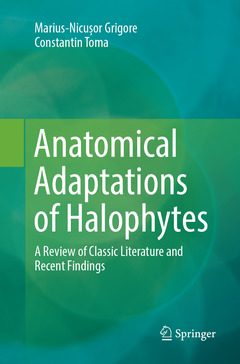Description
Anatomical Adaptations of Halophytes, Softcover reprint of the original 1st ed. 2017
A Review of Classic Literature and Recent Findings
Authors: Grigore Marius-Nicușor, Toma Constantin
Language: English
Subject for Anatomical Adaptations of Halophytes:
Approximative price 158.24 €
In Print (Delivery period: 15 days).
Add to cart
Anatomical Adaptations of Halophytes
Publication date: 09-2018
Support: Print on demand
Publication date: 09-2018
Support: Print on demand
Approximative price 158.24 €
In Print (Delivery period: 15 days).
Add to cart
Anatomical Adaptations of Halophytes
Publication date: 10-2017
Support: Print on demand
Publication date: 10-2017
Support: Print on demand
Description
/li>Contents
/li>Biography
/li>Comment
/li>
This book describes important anatomical adaptations in halophytes, based on a large review of relevant literature (since the 17th century) and recent research findings. Scientists involved in the study of plant biology, from a molecular to ecosystemic level, will find information about all major structural strategies of salt tolerant plants.
The book starts with an introductory theoretical background, where several aspects related to the definition and classification of halophytes and saline environments are included. Major anatomical adaptations are then grouped around major concepts: succulence, tracheoidioblasts, salt secretion, Kranz anatomy, successive cambia, and bulliform cells. Each of them is treated following a general scheme: introductory considerations, anatomical basis, and ecological implications; a review of relevant literature is then conducted and the text is supported by a large number of figures, especially ink drawings and color micrographs.
The book starts with an introductory theoretical background, where several aspects related to the definition and classification of halophytes and saline environments are included. Major anatomical adaptations are then grouped around major concepts: succulence, tracheoidioblasts, salt secretion, Kranz anatomy, successive cambia, and bulliform cells. Each of them is treated following a general scheme: introductory considerations, anatomical basis, and ecological implications; a review of relevant literature is then conducted and the text is supported by a large number of figures, especially ink drawings and color micrographs.
Part 1. Haplotype and Saline Environment.
Chapter 1. Haplotype Definition and Classification
Chapter 2. Saline Environments
Part 2. Major Anatomical Adaptations.
Chapter 3. Succulence
Chapter 4.Tracheoidioblasts (spiral cells) and Stererdes (spicular cells).
Chapter 5. Salt Secretion.
Chapter 6. Kranz Anatomy.
Chapter 7. Successive Cambia.
Chapter 8. Bulliform Cells.
Marius Grigore received his BSc and PhD in Biology from Alexandru Ioan Cuza University in Iași, Romania. He was subsequently a postdoctoral fellow in the field of halophyte ecophysiology at the same university, as well as an invited researcher at the Polytechnic University of Valencia, Spain. His primary research interests are in the ecology, anatomy and physiology of halophytes. He has published 6 books and over 60 peer-reviewed papers on halophytes. In 2016, he was awarded the Romanian Academy’s “Emil Racoviță” prize for the book - Halophytes: An Integrative Anatomical Study, published with Springer in 2014. He is currently an editor at Alexandru Ioan Cuza University Press.
Constantin Toma received his BSc and PhD in Biology from Alexandru Ioan Cuza University in Iași, Romania. He is full member of the Romanian Academy and an honorary member of the Sciences Academy of the Republic of Moldova. He has extensive expertise in plant morphology and anatomy and has published 30 books and more than 500 papers. Four of his books were awarded by the Romanian Academy, the last in 2016 book - Halophytes: An Integrative Anatomical Study (Springer). He is currently a professor emeritus at Alexandru Ioan Cuza University and honorary president of the National Society of Biological Sciences.
Constantin Toma received his BSc and PhD in Biology from Alexandru Ioan Cuza University in Iași, Romania. He is full member of the Romanian Academy and an honorary member of the Sciences Academy of the Republic of Moldova. He has extensive expertise in plant morphology and anatomy and has published 30 books and more than 500 papers. Four of his books were awarded by the Romanian Academy, the last in 2016 book - Halophytes: An Integrative Anatomical Study (Springer). He is currently a professor emeritus at Alexandru Ioan Cuza University and honorary president of the National Society of Biological Sciences.
Discusses plant adaptation to saline environments
Includes several hundred photographs and detailed drawings
Reviews the work of classical botanists since the 17th century
© 2024 LAVOISIER S.A.S.

